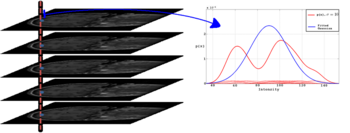Difference between revisions of "2008 Winter Project Week GroupwiseReg"
From NAMIC Wiki
| (4 intermediate revisions by the same user not shown) | |||
| Line 10: | Line 10: | ||
===Key Investigators=== | ===Key Investigators=== | ||
* MIT: Serdar Balci, Polina Golland | * MIT: Serdar Balci, Polina Golland | ||
| − | * Kitware: | + | * Kitware: Brad Davis |
| − | + | * SCI: Casey Goodlett | |
<div style="margin: 20px;"> | <div style="margin: 20px;"> | ||
| Line 19: | Line 19: | ||
<h1>Objective</h1> | <h1>Objective</h1> | ||
| − | The goal of this project is to | + | The goal of this project is to expand the NAMIC Software Kit with the addition of an image-based atlas |
| − | + | building algorithm that was developed by Polina Golland’s lab at MIT. The basic functionality of this software will | |
| + | be demonstrated to the NAMIC community at the January 2008 NAMIC all-hands meeting. A secondary | ||
| + | goal is to begin the process of gathering usability and interface requests from targeted clinical collaborators. | ||
| + | It is intended that users’ requests will be incorporated in to a future project aimed at tailoring this software | ||
| + | for widespread NAMIC use. | ||
| + | |||
| + | See our [[Projects:GroupwiseRegistration| Algorithm Project Page]] for more details. | ||
</div> | </div> | ||
| Line 28: | Line 34: | ||
<h1>Approach, Plan </h1> | <h1>Approach, Plan </h1> | ||
| − | + | The registration algorithms are already available as C++ sourcecode. We plan to integrate them into the NAMIC community by: | |
| − | The | ||
| − | |||
| − | |||
| − | + | *Adapt sourcecode to utilize the command-line parsing mechanism that was designed for Slicer3 external modules. | |
| − | + | *Create a simple Slicer3 graphical user interface (external module) that allows a user to generate an atlas from their data. | |
| − | + | *User Feedback. During the January 2008 NAMIC all-hands meeting we will solicit feedback on this project from potential collaborators. | |
</div> | </div> | ||
Latest revision as of 15:17, 11 January 2008
Home < 2008 Winter Project Week GroupwiseReg Return to 2008_Winter_Project_Week |
 Figure 1: On the left is shown a stack of images and a sample pixel stack around a cortical region. On the left is shown the Gaussian(blue) fittet to a real sample from the dataset we used along with the non-parametric density estimate(red). Note that the distribution is bi-modal because of white matter-gray matter transaction. |
Key Investigators
- MIT: Serdar Balci, Polina Golland
- Kitware: Brad Davis
- SCI: Casey Goodlett
Objective
The goal of this project is to expand the NAMIC Software Kit with the addition of an image-based atlas building algorithm that was developed by Polina Golland’s lab at MIT. The basic functionality of this software will be demonstrated to the NAMIC community at the January 2008 NAMIC all-hands meeting. A secondary goal is to begin the process of gathering usability and interface requests from targeted clinical collaborators. It is intended that users’ requests will be incorporated in to a future project aimed at tailoring this software for widespread NAMIC use.
See our Algorithm Project Page for more details.
Approach, Plan
The registration algorithms are already available as C++ sourcecode. We plan to integrate them into the NAMIC community by:
- Adapt sourcecode to utilize the command-line parsing mechanism that was designed for Slicer3 external modules.
- Create a simple Slicer3 graphical user interface (external module) that allows a user to generate an atlas from their data.
- User Feedback. During the January 2008 NAMIC all-hands meeting we will solicit feedback on this project from potential collaborators.
Progress
Jan 2008 Project Week
References
- S.K. Balci, P. Golland, M.E. Shenton, W.M. Wells III. Free-Form B-spline Deformation Model for Groupwise Registration. In Proceedings of MICCAI 2007 Statistical Registration Workshop: Pair-wise and Group-wise Alignment and Atlas Formation, 23-30, 2007.